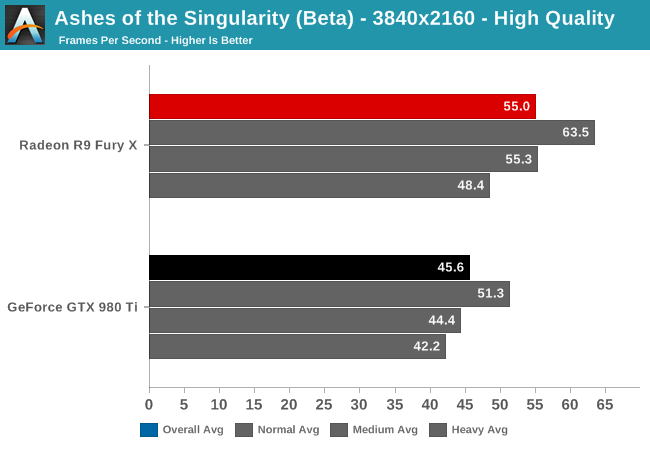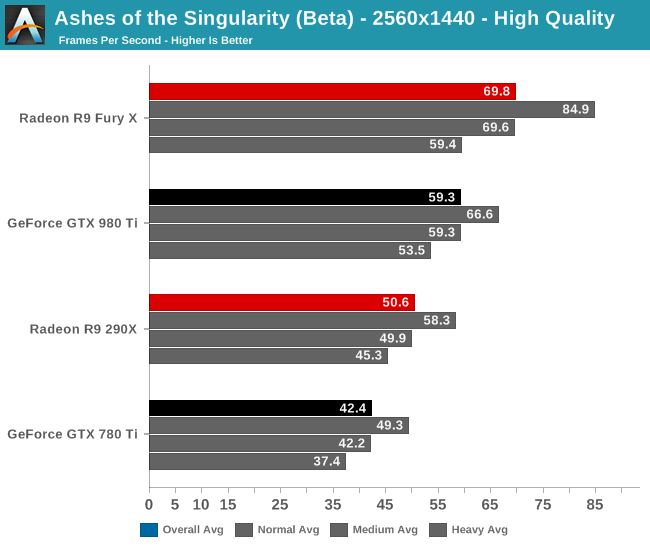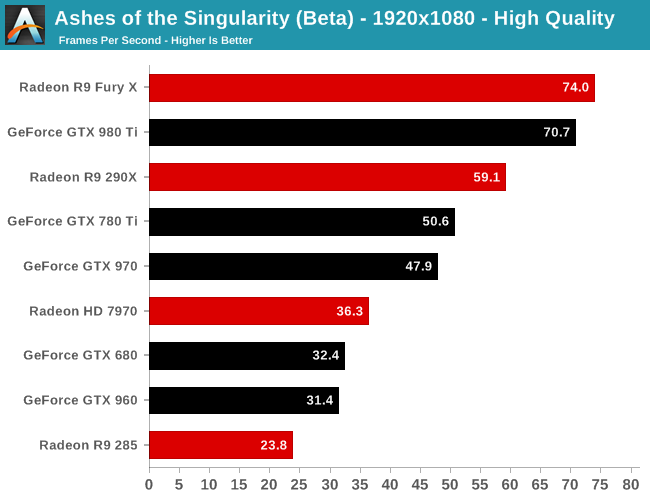Ashes of the Singularity Revisited: A Beta Look at DirectX 12 & Asynchronous Shading
by Daniel Williams & Ryan Smith on February 24, 2016 1:00 PM ESTDirectX 12 Single-GPU Performance
We’ll start things off with a look at single-GPU performance. For this, we’ve grabbed a collection of RTG and NVIDIA GPUs covering the entire DX12 generation, from GCN 1.0 and Kepler to GCN 1.2 and Maxwell. This will give us a good idea of how the game performs both across a wide span of GPU performance levels, and how (if at all) the various GPU generational changes play a role.
Meanwhile unless otherwise noted, we’re using Ashes’ High quality setting, which turns up a number of graphical features and also utilizes 2x MSAA. It’s also worth mentioning that while Ashes does allow async shading to be turned off and on, this option is on by default unless turned off in the game’s INI file.

Starting at 4K, we have the GeForce GTX 980 Ti and Radeon R9 Fury X. On the latest beta the Fury X has a strong lead over the normally faster GTX 980 Ti, beating it by 20% and coming close to hitting 60fps.

When we drop down to 1440p and introduce last-generation’s flagship video cards, the GeForce GTX 780 Ti and Radeon R9 290X, the story is much the same. The Fury X continues to hold a 10fps lead over the GTX 980 Ti, giving it an 18% lead. Similarly, the R9 290X has an 8fps lead over the 780 Ti, translating into a 19% performance lead. This is a significant turnabout from where we normally see these cards, as 780 Ti traditionally holds a lead over the 290X.
Meanwhile looking at the average framerates with different batch count intensities, there admittedly isn’t much remarkable here. All cards take roughly the same performance hit with increasingly larger batch counts.

Finally at 1080p, with our full lineup of cards we can see that RTG’s lead in this latest beta is nearly absolute. The 2012 flagship battle between the 7970 and the GTX 680 puts the 7970 in the lead by 12%, or just shy of 4fps. Elsewhere the GTX 980 Ti does close on the Fury X, but RTG’s current-gen flagship remains in the lead.
The one outlier here is the Radeon R9 285, which is the only 2GB RTG card in our collection. At this point we suspect it’s VRAM limited, but it would require further investigation.










153 Comments
View All Comments
rarson - Wednesday, February 24, 2016 - link
Yeah, because people who bought a 980 Ti are already looking to replace them...Aspiring Techie - Wednesday, February 24, 2016 - link
I'm pretty sure that Nvidia's Pascal cards will be optimized for DX12. Still, this gives AMD a slight advantage, which they need pretty badly now.testbug00 - Wednesday, February 24, 2016 - link
*laughs*Pascal is more of the same as Maxwell when it comes to gaming.
Mondozai - Thursday, February 25, 2016 - link
Pascal is heavily compute-oriented, which will affect how the gaming lineup arch will be built. Do your homework.testbug00 - Thursday, February 25, 2016 - link
Sorry, Maxwell already can support packed FP16 operations at 2x the rate of FP32 with X1.The rat of compute will be pretty much exclusive to GP100. Like how Kepler had a gaming line and GK110 for compute.
MattKa - Thursday, February 25, 2016 - link
*laughs*I'd like to borrow your crystal ball...
You lying sack of shit. Stop making things up you retarded ass face.
testbug00 - Thursday, February 25, 2016 - link
What does Pascal have over Maxwell according to Nvidia again? Bolted on FP64 units?CiccioB - Sunday, February 28, 2016 - link
I have not read anything about Pascal from nvidia outside the FP16 capabilities that are HPC oriented (deep learning).Where have you read anything about how Pascal cores/SMX/cache and memory controller are organized? Are they still using crossbar or they finally passed to a ring bus? Are caches bigger or faster? What are the ratio of cores/ROPs/TMUs? How much bandwidth for each core? How much has the compressed memory technology improved? Have cores doubled the ALUs or they have made more independent core? How much independent? Is the HW scheduler now able to preempt the graphics thread or it still can't? How many threads can it support? Is the Voxel support better and able to be used heavily in scenes to make global illumination quality difference?
I have not read anything about this points. Have you some more info about them?
Because what I could see is that at a first glance even Maxwell was not really different than Kepler. But in reality the performance were quite different in many ways.
I think you really do not know anything about what you are talking about,.
You are just expressing your desire and hopes like any other fanboy as a mirror of the frustration you have suffered all these years with the less capable AMD architecture you have been using up to now. You just hop nvidia has stopped and AMD finally made a step forward. It may be you are right. But you can't say now, nor I would going telling such stupid thing you were saying without anything as a fact.
anubis44 - Thursday, February 25, 2016 - link
I think nVidia's been caught with their pants down, and Pascal doesn't have hardware schedulers to perform async compute, either. It may be that AMD has seriously beaten them this time.anubis44 - Thursday, February 25, 2016 - link
nVidia wasn't expecting AMD to force Microsoft's hand and release DX12 so soon. I have a feeling Pascal, like Maxwell, doesn't have hardware schedulers, either. It's beginning to look like nVidia's been check-mated by AMD here.